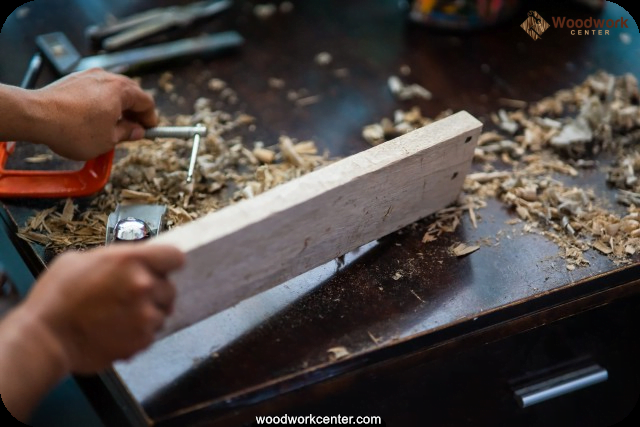Woodworking jigs are an essential tool for serious woodworkers who seek precision and efficiency in their projects. These specialized tools not only help in making accurate cuts, joints, and edges but also enhance the overall quality of the finished piece. In this article, we will explore the different types of must-have woodworking jigs that every serious woodworker should have in their workshop.
Understanding the importance of woodworking jigs is crucial for anyone looking to take their woodworking skills to the next level. Whether it’s creating seamless joints or cutting precise angles, having the right jigs can make all the difference in achieving professional-looking results. From miter and table saw jigs to dovetail and mortise and tenon jigs, each type serves a specific purpose in enhancing the accuracy and efficiency of woodworking projects.
In this comprehensive guide, we will delve into the essential woodworking jigs for precise cuts and strong joints, as well as explore the importance of router jigs in various woodworking tasks. Additionally, we will discuss innovative and time-saving jigs for specialized projects, along with tips and tricks for effectively using these must-have tools to maximize precision and efficiency in woodworking.
Understanding the Different Types of Woodworking Jigs
Woodworking jigs are essential tools for serious woodworkers looking to achieve precise and accurate results in their projects. Understanding the different types of woodworking jigs is crucial for selecting the right one for the task at hand. From joinery jigs to cutting jigs, each type serves a specific purpose in ensuring that woodworking tasks are completed with efficiency and precision.
Joinery jigs are designed to assist woodworkers in creating strong and seamless joints. This includes dovetail jigs, box joint jigs, and mortise and tenon jigs. Dovetail jigs are particularly useful for creating interlocking joints that are both sturdy and visually appealing. Box joint jigs are ideal for making square or rectangular joints while mortise and tenon jigs help in creating a traditional joint that is commonly used in furniture making.
On the other hand, cutting jigs such as miter, table saw, and circular saw jigs are essential for achieving accurate cuts in woodworking projects. Miter jigs help in making precise angled cuts while table saw and circular saw jigs ensure straight and consistent cuts, particularly when working with large pieces of wood.
Woodworkers must have woodworking jigs of different types in their arsenal to handle various tasks effectively. Each type serves a specific purpose in ensuring precision and efficiency while working on different woodworking projects.
| Woodworking Jig Type | Function |
|---|---|
| Miter Jig | To make precise angled cuts |
| Table Saw Jig | To ensure straight and consistent cuts |
| Circular Saw Jig | To ensure straight and consistent cuts on large pieces of wood |
Essential Woodworking Jigs for Precise and Accurate Cuts
Woodworking jigs are essential tools for any serious woodworker. They help to ensure precise and accurate cuts, improve efficiency, and enhance the overall quality of woodworking projects. When it comes to woodworking jigs, there are several must-have options that every woodworker should consider adding to their collection.
One of the most important woodworking jigs for precise and accurate cuts is the miter jig. This type of jig is used to guide a hand tool or power tool for making accurate miter cuts at a specific angle. Whether you are working on frames, molding, or other angled cuts, a miter jig can make the process much easier and more precise.
Another must-have woodworking jig is the table saw jig. This type of jig helps woodworkers make straight and consistent cuts on a table saw, which is essential for many woodworking projects. From ripping boards to cutting panels, a table saw jig can help ensure accuracy and safety in the workshop.
Circular saw jigs are also an essential addition to any woodworker’s toolkit. These jigs help guide circular saws to make precise cuts, whether it’s for crosscuts, rip cuts, or angled cuts. With the help of a circular saw jig, woodworkers can achieve professional-quality results with ease.
| Woodworking Jig | Use |
|---|---|
| Miter Jig | Guiding hand or power tools for accurate miter cuts |
| Table Saw Jig | Making straight and consistent cuts on a table saw |
| Circular Saw Jig | Guiding circular saws for precise crosscuts, rip cuts, or angled cuts |
Must-Have Jigs for Creating Strong and Seamless Joints
Woodworking jigs are essential tools for creating strong and seamless joints in woodworking projects. They provide precision and accuracy, making it easier for woodworkers to achieve perfect unions between pieces of wood. There are several must-have jigs for creating strong and seamless joints, including dovetail, box joint, and mortise and tenon jigs.
Dovetail Jig
One of the most popular woodworking jigs for creating strong joints is the dovetail jig. This type of jig allows woodworkers to create symmetrical, interlocking joints that are both visually appealing and durable. Dovetail joints are commonly used in drawers, cabinets, and other furniture pieces where a strong bond is crucial. With a dovetail jig, woodworkers can easily cut precise dovetail joints with consistent spacing and depth.
Box Joint Jig
Another essential woodworking jig for creating strong joints is the box joint jig. This type of jig is designed to help woodworkers create sturdy, interlocking finger joints that are ideal for drawer construction, box-making, and other joinery applications. With a box joint jig, woodworkers can quickly and accurately cut multiple fingers at once, resulting in tight-fitting joints that enhance the overall strength of the project.
Mortise and Tenon Jig
The mortise and tenon joint is a classic woodworking joint that provides exceptional strength and stability. A mortise and tenon jig is a must-have tool for creating this type of joint with precision. This jig allows woodworkers to cut accurate mortises and tenons quickly and consistently, ensuring a perfect fit every time. Whether it’s for furniture construction or architectural woodworking, a mortise and tenon jig is indispensable for achieving seamless joints in woodworking projects.
The Importance of Router Jigs in Woodworking
Router jigs are essential tools for any serious woodworker, as they provide precision and accuracy when working with routers. There are different types of router jigs that serve specific purposes, including template jigs, edge jigs, and mortising jigs. These must-have woodworking jigs can make a significant difference in the quality of your work and the efficiency of your woodworking projects.
Template jigs are used to guide the router along a predetermined path, allowing woodworkers to create consistent and repeatable shapes. This type of jig is extremely useful for making identical cuts for things like inlays, decorative patterns, or curved edges. Edge jigs, on the other hand, are designed to help woodworkers create straight and even cuts along the edge of a workpiece. They ensure that the router remains parallel to the edge, resulting in precise and clean cuts.
Mortising jigs are specifically designed for creating mortises, which are rectangular holes used to join pieces of wood together. Using a mortising jig with a router allows woodworkers to cut accurate and smooth mortises quickly and efficiently. With these essential router jigs in your arsenal, you can elevate the quality of your woodworking projects while saving time and effort.
Innovative and Time-Saving Woodworking Jigs for Specialized Projects
Woodworking jigs are essential tools for serious woodworkers, helping them achieve precise and accurate cuts, create strong joints, and save time on specialized projects. In this section, we will explore innovative woodworking jigs that are specifically designed for specialized projects such as cabinets, drawers, and doweling.
Cabinet Jigs
Cabinet jigs are a must-have for woodworking projects that involve building cabinets. These jigs help woodworkers drill shelf pin holes for adjustable shelves with consistent accuracy. They also aid in installing drawer slide hardware in a uniform manner, ensuring that drawers open and close smoothly. By using cabinet jigs, woodworkers can streamline the process of cabinet construction and achieve professional-looking results.
Drawer Jigs
When it comes to creating drawers for furniture or cabinetry, drawer jigs are indispensable. These jigs assist woodworkers in accurately positioning mounting brackets for drawer slides, ensuring that the drawers fit perfectly within their designated spaces. Drawer jigs also help in drilling the holes needed for attaching drawer pulls or handles with precision. With the use of drawer jigs, woodworkers can achieve seamless and functional drawers for their woodworking projects.
Doweling Jigs
Doweling is a popular technique used to join wood pieces together seamlessly and securely. Doweling jigs aid in drilling precisely aligned holes for inserting dowels into workpieces, resulting in strong and durable joints. These specialized woodworking jigs come in various designs such as self-centering doweling jigs or adjustable doweling jigs to accommodate different dowel sizes and spacing requirements. By utilizing doweling jigs, woodworkers can simplify the process of creating dowel joints while ensuring accuracy and consistency throughout their projects.
Innovative woodworking jigs designed for specialized projects like cabinets, drawers, and doweling play a crucial role in enhancing efficiency and precision in woodworking tasks. By incorporating these must-have woodworking jigs into their tool collection, woodworkers can elevate the quality of their craftsmanship and tackle specialized projects with confidence.
DIY Woodworking Jigs
Woodworking jigs are an essential tool for any serious woodworker, but they can also be customized for personal woodworking projects. Whether you’re a beginner or an experienced woodworker, having the ability to create your own DIY woodworking jigs can significantly enhance the quality and efficiency of your work. Here are a few types of DIY woodworking jigs that can be customized for your specific project needs:
- Customized Clamping Jig: A clamping jig is essential for holding pieces of wood securely in place while you work on them. By customizing the dimensions and angles of the jig, you can ensure a perfect fit for your unique project requirements.
- Adjustable Template Jig: A template jig is used to guide cutting tools, such as routers or saws, to create precise and consistent shapes. Creating an adjustable template jig allows you to easily modify the size or shape of your cuts without needing to craft entirely new templates for each variation.
- Specialized Drilling Jig: For projects requiring multiple holes drilled at specific angles or depths, a specialized drilling jig can be customized to align perfectly with your measurements and specifications.
Customizing your own DIY woodworking jigs not only ensures they meet the exact needs of your project, but it also allows for greater flexibility and creativity in how you approach different woodworking tasks. Additionally, creating personalized jigsaw also gives you the opportunity to experiment with new designs and techniques, enhancing your skills as a woodworker.
By taking the time to customize your woodworking jigs for each project, you’ll find that you can achieve more precise cuts and joints while saving time and effort in the process. The flexibility and potential for innovation that come with DIY woodworking jigs make them an invaluable asset for woodworkers looking to take their craft to the next level.
Tips and Tricks for Using Woodworking Jigs Effectively
In conclusion, woodworking jigs are indispensable tools for serious woodworkers who strive for precision and efficiency in their projects. Understanding the different types of woodworking jigs, from joinery jigs to cutting jigs, is essential for anyone looking to take their woodworking skills to the next level. The must-have jigs for creating strong and seamless joints, such as dovetail, box joint, and mortise and tenon jigs, are crucial for achieving professional results.
Router jigs also play a vital role in woodworking, with template, edge, and mortising jigs being important tools for creating intricate designs and smooth edges. Additionally, innovative and time-saving woodworking jigs like cabinet, drawer, and doweling jigs can help woodworkers tackle specialized projects with ease.
For those looking to customize their woodworking experience, DIY woodworking jigs offer the opportunity to tailor jigs to fit personal projects and specific needs. However, it’s important not to overlook the tips and tricks for using woodworking jigs effectively in order to maximize their potential for precision and efficiency.
With the right knowledge and skills in using these must-have woodworking jigs, woodworkers can elevate the quality of their craftsmanship and achieve outstanding results in their creations. Whether it’s making precise cuts or creating seamless joints, investing in high-quality woodworking jigs is an essential step toward becoming a proficient woodworker.
Frequently Asked Questions
What Is the Best Wood for Woodworking Jigs?
The best wood for woodworking jigs is typically hardwood, such as maple or birch, due to its durability and stability. These woods are less likely to warp or wear down over time, ensuring the jig maintains precision.
Why Are Jigs So Valuable in a Wood Shop?
Jigs are incredibly valuable in a wood shop because they help replicate precise cuts and measurements consistently. This not only saves time but also ensures that every piece of woodwork is uniform and accurate.
Is MDF Good for Making Jigs?
MDF, or medium-density fiberboard, can be good for making jigs due to its smooth and flat surface, which allows for precise measurements and cuts. However, it may not be as durable as hardwood and could succumb to wear over time with heavy use.

Hi everyone! I’m a woodworker and blogger, and this is my woodworking blog. In my blog, I share tips and tricks for woodworkers of all skill levels, as well as project ideas that you can try yourself.





